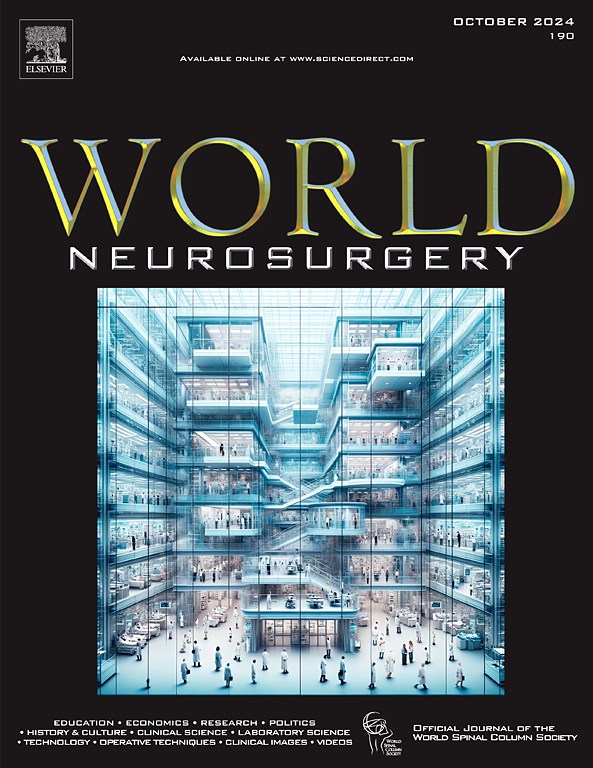小儿神经外科术中不良事件及围手术期预后的评价。
IF 2.1
4区 医学
Q3 CLINICAL NEUROLOGY
引用次数: 0
摘要
质量监测和改进是儿科神经外科有效的风险评估和手术准备的关键。本研究评估了ClassIntra分类术中并发症的可靠性及其预测儿科患者术后预后的潜力。材料和方法:在一所三级医疗中心的前瞻性队列研究中,我们分析了47名接受各种神经外科手术的儿科患者。在整个围手术期系统收集数据,重点关注术前特征、术中变量和术后恢复指标。结果:使用ClassIntra分级系统将队列分为3组:CI 0 (N=24), CI 1 (N=20)和CI≥2 (N=3)。平均年龄为7.0岁,各组间没有显著的人口统计学差异。ClassIntra分级越高,手术时间越长(CI 0 126.6分钟,CI 1 227.6分钟,CI≥2 260.7分钟,P=0.01)。术中重大不良事件组患者神经功能恶化程度较高(P=0.03), CI≥2组患者90天再入院率较高(P < 0.01)。结论:术中并发症对小儿神经外科术后恢复有重要影响。较长的手术时间和较差的神经预后与较高的ClassIntra评分相关,这强调了改进监测和降低风险策略的必要性。本文章由计算机程序翻译,如有差异,请以英文原文为准。
Evaluation of Intraoperative Adverse Events and Perioperative Outcomes in Pediatric Neurosurgery
Objective
Quality monitoring and improvement are crucial in pediatric neurosurgery for effective risk assessment and surgical preparation. This study evaluates the reliability of the ClassIntra classification for intraoperative complications and its potential for predicting postoperative outcomes in pediatric patients.
Methods
In this prospective cohort study at a tertiary care center, we analyzed 47 pediatric patients undergoing various neurosurgical procedures. Data were systematically collected throughout the perioperative period, focusing on preoperative characteristics, intraoperative variables, and postoperative recovery metrics.
Results
The cohort was categorized using the ClassIntra grading system into 3 groups: CI = 0 (N = 24), CI = 1 (N = 20), and CI ≥ 2 (N = 3). The mean age was 7.0 years, with no significant demographic differences across groups. Operative times increased with higher ClassIntra grades (126.6 minutes for CI = 0, 227.6 minutes for CI = 1, and 260.7 minutes for CI ≥ 2; P = 0.01). Patients with major intraoperative adverse events showed higher neurological deterioration (P = 0.03) and increased 90-day readmission rates in the CI ≥ 2 group (P < 0.01).
Conclusions
Intraoperative complications significantly affect postoperative recovery in pediatric neurosurgery. Longer operative times and worse neurological outcomes correlate with higher ClassIntra ratings, emphasizing the need for improved monitoring and risk-reduction strategies.
求助全文
通过发布文献求助,成功后即可免费获取论文全文。
去求助
来源期刊

World neurosurgery
CLINICAL NEUROLOGY-SURGERY
CiteScore
3.90
自引率
15.00%
发文量
1765
审稿时长
47 days
期刊介绍:
World Neurosurgery has an open access mirror journal World Neurosurgery: X, sharing the same aims and scope, editorial team, submission system and rigorous peer review.
The journal''s mission is to:
-To provide a first-class international forum and a 2-way conduit for dialogue that is relevant to neurosurgeons and providers who care for neurosurgery patients. The categories of the exchanged information include clinical and basic science, as well as global information that provide social, political, educational, economic, cultural or societal insights and knowledge that are of significance and relevance to worldwide neurosurgery patient care.
-To act as a primary intellectual catalyst for the stimulation of creativity, the creation of new knowledge, and the enhancement of quality neurosurgical care worldwide.
-To provide a forum for communication that enriches the lives of all neurosurgeons and their colleagues; and, in so doing, enriches the lives of their patients.
Topics to be addressed in World Neurosurgery include: EDUCATION, ECONOMICS, RESEARCH, POLITICS, HISTORY, CULTURE, CLINICAL SCIENCE, LABORATORY SCIENCE, TECHNOLOGY, OPERATIVE TECHNIQUES, CLINICAL IMAGES, VIDEOS
 求助内容:
求助内容: 应助结果提醒方式:
应助结果提醒方式:


